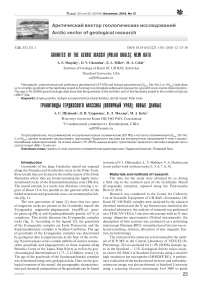Granites of the Gerdiz massif (Polar Urals): new data
Автор: Shuyskiy A.S., Udoratina O.V., Miller E.L., Coble M.A.
Журнал: Вестник геонаук @vestnik-geo
Рубрика: Научные статьи
Статья в выпуске: 12 (288), 2018 года.
Бесплатный доступ
Petrographic, petrochemical and preliminary geochemical (ICP MS) and isotope geochemical (OZrn, Sm-Nd, (Lu-Hf)Zrn) data allow us to consider granitoids of the Gerdizsky massif as forming in an intraplate setting and represent A-type with crust-mantle characteristics. The new U-Pb (SIMS) geochronologic data show that the granitoids of the northern part of the Gerdizsky massif in the northern Urals are (496±7) Ma.
A-type granites, isotopic and geochemical characteristics, gerdiz massif, polar urals
Короткий адрес: https://sciup.org/149129291
IDR: 149129291 | УДК: 552.321.1 | DOI: 10.19110/2221-1381-2018-12-23-30
Текст научной статьи Granites of the Gerdiz massif (Polar Urals): new data
Granitoids of the large Gerdizsky massif are exposed along the Paetarka and Gerdizshor rivers in the Polar Urals. Structurally they are located in the northern part of the block Marunkeu where they are found intruding the highly metamorphosed rocks of the Khanmenkhoyskaya suite (PR 1 hn ). The massif extends in a north-east direction covering a region of about 15×6 km parallel to the general strike of the folded structures and granitoids cross-cut metamorphic fabrics (fig. 1).
The new generation of maps [1] show that two types of magmatic rocks are present in the Gerdizskiy massif: the Evyuganskiy migmatite-plagiogranite ( m ργPR 1 å ), granite gneiss (gγPR 1 å ) and Syadatayakhinskiy granite (γV-ª 1 s) complexes. This article discusses the Evyuganskiy complex rocks (fig. 1). According to the legend [5], the granitoids of the Evyuganskiy complex are Early Proterozoic and the Syadatayakhinskiy complex is Vendian-Cambrian. The age of granitoids of the Evyuganskiy complex was determined by geological data (conglomerates at the base of the overlying Nyaroveyskaya series contain pebbles of similar composition granitoids and plagiogranites to those exposed along Paetarka Creek of the Lapta-Yaha River) as well as by geo-chronological determinations (1.73–2.22 billion. years) [1]. The age of the granitoids of the Syadatayakhinskiy complex was determined using only geological data. Data on the geological structure of the massif, the petrographic characterization and chemical composition of the granitoids can be found
in works of V. I. Okhotnikov, L. V. Mahlaev, V. A. Dushin and in our earlier work on these rocks [1, 3, 4, 7, 8, 9].
Materials and methods of research
The data for the study were obtained by us during a field trip to the northern part of the Gerdizskiy Massif (Evyuganskiy complex), exposed along the Pesaveyyaha River in 2014.
Research was conducted in the Center for Collective Use of Scientific Equipment of UB RAS «Geonauka» (IG Komi SC UB RAS): samples were analyzed by the classical chemical method and the X-ray fluorescence method in the chemical laboratory; the analysis of minerals was performed on a TESCAN VEGA 3 electron microscope with an X-max energy dispersive spectrometer (Oxford instruments); the description of thin sections was conducted on a polarizing microscope Olympus BX51; monofraction of zircons was selected (crushing, division, allocation of non-magnetic fraction, bromforming).
The content of the elements is determined by the method of ICP-MS in the Central Laboratory of VSEGEI (St. Petersburg). Zircon analyzed for U-Pb (SIMS) isotopic ages in the Stanford — U.S. Geological Survey micro analysis center (SUMAC) at Stanford University using a sensitive high-resolution ion microprobe (SHRIMP RG). A preliminary evaluation of the backscattered electron and cathodolu-minescent image was also performed at Stanford University using a scanning electron microscope Jeol 5600 to guide
Table 1. Chemical composition (wt. %) and content of rare elements (ppm) of granitoids of the Gerdiz massif (northern part)
Òàáëèöà 1. Õèìè÷åñêèé ñîñòàâ (ìàñ. %) è ñîäåðæàíèå ýëåìåíòîâ ïðèìåñåé (ã/ò) äëÿ ãðàíèòîèäîâ Ãåðäèçñêîãî ìàññèâà (ñåâåðíàÿ ÷àñòü)
|
Êîìïîíåíòû Components |
A41/14 |
A52/14 |
A34â/14 |
A54/14 |
A34a/14 |
A51/14 |
A35/14 |
A53/14 |
|
SiO 2 |
69.9 |
73.2 |
73.58 |
74.24 |
75.62 |
76.3 |
77.28 |
79.64 |
|
TiO 2 |
0.6 |
0.31 |
0.32 |
0.033 |
0.19 |
0.093 |
0.059 |
0.078 |
|
Al 2 O 3 |
14.66 |
13.04 |
12.76 |
14.82 |
12.39 |
12.54 |
12.25 |
10.49 |
|
FeO |
1.4 |
1.3 |
0.99 |
0.38 |
1.02 |
0.6 |
0.42 |
0.57 |
|
MnO |
0.039 |
0.034 |
0.026 |
0.04 |
0.019 |
0.01 |
0.018 |
0.011 |
|
CaO |
2.17 |
1.24 |
0.93 |
0.4 |
0.93 |
0.4 |
0.4 |
0.4 |
|
MgO |
2.17 |
0.2 |
0.51 |
0.1 |
0.1 |
0.3 |
0.1 |
0.1 |
|
K 2 O |
3.58 |
5.06 |
4.76 |
3.7 |
3.69 |
4.42 |
4.52 |
4.26 |
|
Na 2 O |
3.09 |
3.53 |
3.49 |
5.07 |
3.73 |
3.51 |
3.83 |
3.24 |
|
P 2 O 5 |
0.15 |
0.042 |
0.06 |
0.1 |
0.033 |
0.012 |
0.009 |
0.009 |
|
Ï.ï.ï. |
1.77 |
0.85 |
1.04 |
0.64 |
1.14 |
0.71 |
0.59 |
0.51 |
|
Cóììà |
100.95 |
99.72 |
99.55 |
99.66 |
99.6 |
99.34 |
100.08 |
99.83 |
|
FeO tot |
2.82 |
2.22 |
2.08 |
0.52 |
1.76 |
1.05 |
1.03 |
1.09 |
|
H 2 O |
0.19 |
0.21 |
0.15 |
0.17 |
0.13 |
0.17 |
0.17 |
0.25 |
|
CO 2 |
0.13 |
0.1 |
0.1 |
0.13 |
0.29 |
0.1 |
0.1 |
0.1 |
|
Õàðàêòåðèñòè÷åñêèå îòíîøåíèÿ / Characteristic ratios |
||||||||
|
Ga/Al |
– |
3.13 |
2.79 |
– |
– |
2.92 |
3.21 |
2.47 |
|
K/Rb |
– |
328.16 |
263.43 |
– |
– |
485.89 |
111.67 |
225.25 |
|
Rb/Sr |
– |
1.49 |
3.42 |
– |
– |
13.18 |
43.81 |
10.13 |
|
à. i. |
0.61 |
0.87 |
0.85 |
0.83 |
0.82 |
0.84 |
0.91 |
0.95 |
|
Fe* |
0.42 |
0.86 |
0.70 |
0.74 |
0.91 |
0.66 |
0.85 |
0.86 |
|
Na 2 O+K 2 O |
6.67 |
8.59 |
8.25 |
8.77 |
7.42 |
7.93 |
8.35 |
7.50 |
|
Na 2 O/K 2 O |
0.86 |
0.70 |
0.73 |
1.37 |
1.01 |
0.79 |
0.85 |
0.76 |
|
ASI |
1.15 |
0.97 |
1.02 |
1.15 |
1.05 |
1.11 |
1.03 |
0.98 |
|
Ýëåìåíòû ïðèìåñè / Impurity elements |
||||||||
|
V |
– |
12.1 |
11.3 |
– |
– |
9.6 |
7.34 |
7.9 |
|
Cr |
– |
23.9 |
26.2 |
– |
– |
22.9 |
24.5 |
25.6 |
|
Co |
– |
1.65 |
1.29 |
– |
– |
0.5 |
0.5 |
0.5 |
|
Ni |
– |
10.2 |
7.28 |
– |
– |
6.05 |
6.68 |
6.54 |
|
Cu |
– |
5.25 |
3.13 |
– |
– |
18.6 |
5.85 |
2 |
|
Zn |
– |
46.1 |
27.7 |
– |
– |
24.6 |
27.1 |
26.4 |
|
Ga |
– |
20.3 |
18.1 |
– |
– |
18.9 |
20.8 |
16 |
|
Rb |
– |
128 |
150 |
– |
– |
199 |
336 |
157 |
|
Sr |
– |
85.9 |
43.9 |
– |
– |
15.1 |
7.67 |
15.5 |
|
Y |
– |
42.8 |
38.9 |
– |
– |
34.3 |
27.2 |
31.7 |
|
Zr |
– |
316 |
181 |
– |
– |
143 |
121 |
103 |
|
Nb |
– |
17.3 |
12 |
– |
– |
19.7 |
37.6 |
16.2 |
|
Mo |
– |
2.14 |
2.84 |
– |
– |
1.76 |
1.41 |
1.56 |
|
Sn |
– |
5 |
6.65 |
– |
– |
5.22 |
15.2 |
4.61 |
|
Cs |
– |
0.93 |
0.77 |
– |
– |
0.72 |
1.53 |
0.4 |
|
Ba |
– |
732 |
183 |
– |
– |
181 |
16.5 |
41 |
|
La |
– |
124 |
60.4 |
– |
– |
8.96 |
5.7 |
17 |
|
Ce |
– |
221 |
116 |
– |
– |
35 |
16.2 |
50 |
|
Pr |
– |
25.1 |
12.5 |
– |
– |
2.52 |
2.23 |
5.09 |
|
Nd |
– |
78 |
44 |
– |
– |
8.05 |
8.57 |
18 |
|
Sm |
– |
12.8 |
7.46 |
– |
– |
2.3 |
2.61 |
4.69 |
|
Eu |
– |
1.46 |
0.56 |
– |
– |
0.15 |
0.061 |
0.12 |
|
Gd |
– |
11.1 |
7.58 |
– |
– |
2.95 |
3.06 |
3.99 |
|
Tb |
– |
1.46 |
1.05 |
– |
– |
0.67 |
0.61 |
0.64 |
|
Dy |
– |
7.53 |
6.71 |
– |
– |
5.18 |
4.44 |
5.09 |
|
Ho |
– |
1.63 |
1.49 |
– |
– |
1.25 |
0.98 |
1.16 |
|
Er |
– |
4.32 |
3.83 |
– |
– |
3.71 |
3.25 |
3.4 |
|
Tm |
– |
0.67 |
0.55 |
– |
– |
0.65 |
0.55 |
0.51 |
|
Yb |
– |
3.82 |
3.45 |
– |
– |
3.97 |
3.8 |
3.5 |
|
Lu |
– |
0.64 |
0.5 |
– |
– |
0.57 |
0.63 |
0.56 |
|
Hf |
– |
9.77 |
5.58 |
– |
– |
5.56 |
5.63 |
4.04 |
|
Ta |
– |
1.22 |
1.06 |
– |
– |
2.37 |
3.82 |
1.39 |
|
Pb |
– |
32.8 |
28.4 |
– |
– |
26 |
19.9 |
30.5 |
|
Th |
– |
24.2 |
22.6 |
– |
– |
25.6 |
25.5 |
19.1 |
|
U |
– |
2.4 |
2.01 |
– |
– |
1.7 |
2.08 |
1.58 |
Note:«—» not determined, Fe* — iron index (Fetot/(Fetot+Mg)), a. i. — agpait index (Na+ K/Al), ASI — [Al/Ca — 1.67P + Na + K]
Примечание: «—» ^е определялось, Fe* — индекс железистости (Fetot/(Fetot+Mg)), a. i. — агпаитовый индекс (Na + K/Al), ASI — [Al/Ca –1.67P + Na +K]
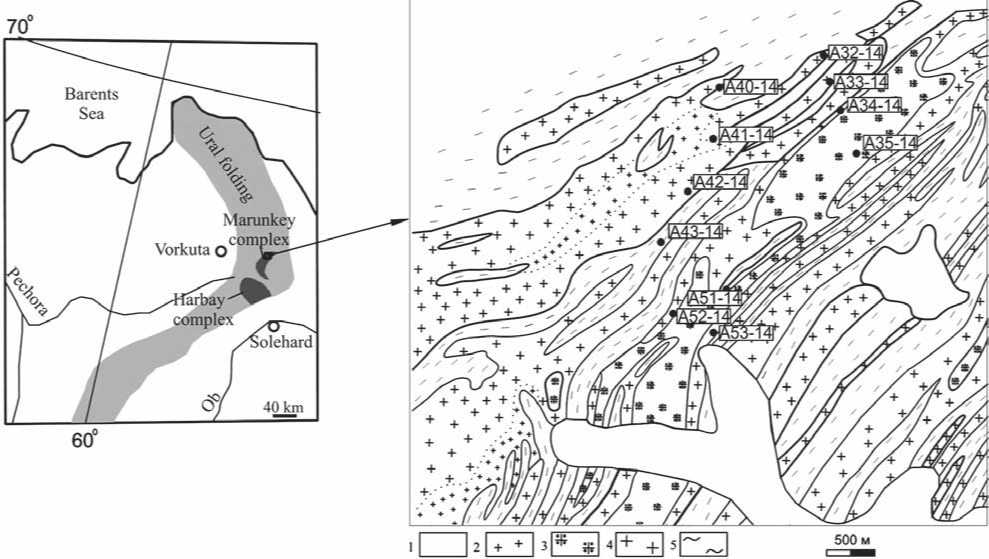
Fig. 1. Schematic geological map of Gerdizsky massif [4]: 1 — Quaternary deposits undivided, 2 — fine-grained granite, 3 — coarsegrained granite, 4 — microcline granite, 5 — precambrian shales
Рис. 1. Схематическая геологическая карта северо-восточной части Гердизского массива по [4]: 1 — четвертичные отложения нерасчлененные, 2 — мелкозернистый гранит, 3 — крупнозернистый гранит, 4 — микроклиновый гранит, 5 — докембрийские сланцы
Table 2. Results of U-Pb-isotope studies of zircons and crystallization temperature Таблица 2. Результаты U-Pb-изотопных исследований и температуры кристаллизации в исследованных цирконах
|
Зерно, Кратер Grain, crater |
206Pbc, % |
Содержания, мкг Content, mkg |
232Th |
Возраст, млн лет Age Ma |
D,% |
Изотопные отношения Isotope ratios |
Rh o |
T (°C) (1.0/0.7) |
|||||
|
206Pb* |
U |
Th |
238U |
206 Pb/ 238 U |
207 Pb/ 206 Pb |
207 Pb/ 206 Pb |
207Pb/235U |
206 Pb/ 238 U |
|||||
|
7.1ц |
0.06 |
25.2 |
395 |
228 |
0.6 |
461.5±19.2 |
445.1±25.9 |
-4 |
0.0558±1.2 |
0.57±4.4 |
0.074±4.2 |
1 |
726 |
|
8.1к |
0.16 |
22.6 |
337 |
223 |
0.68 |
484.8±18.7 |
509.9±24.8 |
5 |
0.0575±1.1 |
0.62±4.1 |
0.078±3.9 |
1 |
687 |
|
10.1ц |
0.51 |
73.9 |
1091 |
686 |
0.65 |
489.1±8.8 |
493.2±84.3 |
1 |
0.0571±3.8 |
0.62±4.2 |
0.079±1.8 |
0.4 |
697 |
|
1.1ц |
0.18 |
13.5 |
196 |
147 |
0.77 |
494.8±12.9 |
516.9±55.8 |
4 |
0.0577±2.5 |
0.64±3.7 |
0.080±2.7 |
0.7 |
728 |
|
5.1ц |
0 |
20.3 |
296 |
105 |
0.37 |
495.4±12.8 |
469.8±28.3 |
-6 |
0.0565±1.3 |
0.62±2.9 |
0.080±2.6 |
0.9 |
645 |
|
3.1к |
0.24 |
32.8 |
475 |
270 |
0.59 |
498.8±13.9 |
512.0±26.0 |
3 |
0.0576±1.2 |
0.64±3.1 |
0.080±2.9 |
0.9 |
679 |
|
6.1к |
0.08 |
14.6 |
211 |
83 |
0.41 |
498.9±12.2 |
536.1±30.9 |
7 |
0.0582±1.4 |
0.65±2.9 |
0.081±2.5 |
0.9 |
694 |
|
9.1ц |
0.02 |
24.5 |
354 |
227 |
0.66 |
499.8±12.8 |
488.8±23.5 |
-2 |
0.0570±1.1 |
0.63±2.8 |
0.081±2.6 |
0.9 |
682 |
|
2.1к |
0.46 |
20.8 |
300 |
195 |
0.67 |
500.9±15.4 |
648.6±253.0 |
23 |
0.0613±11.8 |
0.69±12.2 |
0.081±3.0 |
0.2 |
714 |
|
4.1к |
0.13 |
21.6 |
310 |
150 |
0.5 |
502.2±9.3 |
535.9±23.6 |
6 |
0.0582±1.1 |
0.65±2.2 |
0.081±1.9 |
0.9 |
698 |
Note: Isotopic ratios and 206Pb contents are corrected for the measured 204Pb. D — discordance: D = 100 x [age (207Pb / 206Pb) / age (206Pb / 238U) — 1]. Rho is the correlation coefficient between the 206Pb / 238U and 207Pb / 235U isotope ratio detection errors.
Примечание: Изотопные отношения и содержания 206Pb скорректированы по измеренному 204Pb. D — дискордантность: D = 100 x [возраст (207Pb/206Pb) / возраст (206Pb/238U) — 1]. Rho — коэффициент корреляции между ошибками определения изотопных отношений 206Pb/238U и 207Pb/235U spot placement on individual zircons. The isotope composition of oxygen in zircons was measured at the Institute of Nuclear Physics of the SB RAS (Ulan-Ude). The isotope composition of samarium-neodymium was obtained at IGGD RAS (St. Petersburg). The isotopic composition of hafnium was determined at the Institute of Geology and Mineral Resources (Tianjin, China). Details of the instrumental conditions and analytical procedures for Hf isotope analyses have been described by Genget al. [14]
Research results
Granitoids are observed as thin, mostly layered bodies among the metamorphosed rocks of the frame. The granites are pink and light gray, gneissic, medium-grained to finegrained granoblastic, lepidogranoblastic and cataclastic texture (fig. 2). The rocks are composed of K-feldspar (microcline) — 20—25 %, plagioclase (albite) 25—35 %, quartz 3035 %, mica (muscovite) 5—10 %. Secondary minerals: chlorite, calcite. Accessory: epidote (clinozoisite (contents of the 25
Table 3. Hf isotope composition of zircons
Òàáëèöà 3. Èçîòîïíûé ñîñòàâ Hf â öèðêîíàõ
|
Г^Г^ЧОГ^^-Г^ЧОЧО>Г) О\О\О\О\О\О\О\О\О\ ооооооооо 1 1 1 1 1 1 1 1 1 |
|
|
s' & й |,0 Q Н |
ачтг-г\|х>отттх>о ООО^н^нООО^н I—, I—, I—, I—, I—, I—, I—, I—, I—, |
|
Р~ и Ч 9^ н 2 5 Q Н |
чо^нщсют^нг\|тг^ 0\0\0\0\00\0\0\0 0000^000^ |
|
щ W |
ОО Г- Г\| 40 Г\| чо Щ ш ^l-OO^^H^HOOOO^l-^H mV m m V m V m |
|
5 щ W |
^^^40^000^ V m 40 V od m m 40 । 1 1 1 1 1 1 1 1 1 |
|
0 |
'О О, ОС О О О b- Ti T1 -h^h^h^h^^h^h^h^h ООООООООО ООООООООО ООООООООО ооооооооо ооооооооо |
|
щ в |
^нОООГ-’тГ04400т Г^^Н001Г)^-000^-1Г)4О1Г)1П1П4О4О4О1П C<1C<1C<1C<1C<1C<1C<1C<1C<1 оооооооооооооооооо mmmmmmmmm ооооооооо |
|
0 СЧ |
r^t^O^HQO^-r^iDm оотото^ноо ооооооооо ооооооооо ооооооооо ооооооооо ооооооооо |
|
щ 5 |
1Г)^-ОС<100ОС<1^-1Г) mininminr--4or-'in OO^HmOOOOOC ооооооооо |
|
0 сч |
ог^тт^нс<1С4Г^с<1 о^нот^го^нто ттг-от^н’тг^нт ооооооооо ооооооооо ооооооооо ооооооооо |
|
щ 1 |
тхсотохстоо оттоот^г^но 04отс<1то4^н04оо с<1от^ноог^тс<1с<1 mmmm^tmmm^d-ооооооооо ооооооооо |
|
р1 Ц св щ 2 Р-Н н |
т^нотто^ноо 040040040440000 ^m-^-m-^"-^"'^-m^f |
|
" 5 св 5 ^ Ч, OPS' со |
ЯМММЯМЯаП 1—1 1—1 1—1 1—1 1—1 1—1 1—1 1—1 . РсчтНспРНс^^ |
ãäå (176Lu/177Hf)S è (176Hf/177Hf)S èçìåðåííûå çíà÷åíèÿ â îáðàçöå (176Lu/177Hf)CHUR = 0.0332 and (176Hf/177Hf)CHUR,0 = 0.282772 [11, 12]); (176Lu/177Hf)DM= 0.0384 and (176Hf/177Hf)DM = 0.28325 [15]), t — возраст кристаёёизации цирко^а и X = 1.867 х 10-11yr-1 [10, 16]. T DM од^остадий^ый возраст модеёи и T DM2 двухстадий^ый возраст. fC, f S , fDM и f Lu/Hf з^aчe^ия корового источ^ика, образца и депёетирова^^ой ма^тии, соответственно. В ^а0их расчетах fC= —0.72 (испоёьзуя сред^екоровую веёичи^y 176Lu/177Hf = 0.015) и f DM = 0.16 (176Lu/177Hf =
0.0384) [15].
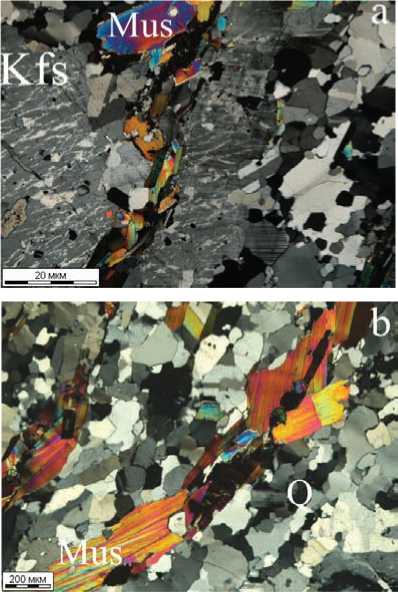
Fig. 2. Cataclastic (a) and lepidogranoblast (b) texture (Kfs – K-feldspar, Mus – muscovite, Q – quartz)
Ðèñ. 2. Êàòàêëàñòè÷åñêàÿ (a) è ëåïèäîãðàíîáëàñòîâàÿ (b) ñòðóêòóðà (Kfs – ÊÏØ, Mus – ìóñêîâèò, Q – êâàðö)
clinozitosite minal from 0.67 to 0.88)) apatite (fluorapatite (3–4 wt. % F), zircon, allanite, garnet (spessartine-grossu-lar-almandin), thorite, fluorite, titanite and ore mineral is represented by magnetite [6]. All minerals are confirmed by microprobe analyzes.
The rocks studied have SiO 2 content 69.9 to 79.64 wt. % and a high amount of alkali (Na 2 O + K 2 O, ranging from 7.42 to 8.59 wt.%), and belong to the family of granites according to the rocks petrochemical classification (fig. 3a and 3b). Moderately alkaline series are moderately potassic rocks rich in alumina (ASI = 0.97–1.15). The content of titanium is very low (TiO 2 = 0.09–0.32 wt. %.). With increasing amounts of silica, the content of (K 2 O + Na 2 O), CaO and FeO, TiO 2 , decrease; the content of Al 2 O 3 , P 2 O 5 is slightly reduced (Tab. 1).
Rocks are characterized by a low total content of rare earth elements (mean value) — 200 ppm. REE spectra (fig. 3c) is characterized by a slight predominance of LREE over HREE ((La/Yb)N — 7.9) with low Eu values (Eu/Eu * — 0.19). Spider diagrams of the rocks under study (fig. 3d) show that they are enriched with large-ion elements (Rb, Th) and have similar or slightly increased content of highly charged elements (Ce, Zr, Sm, Yb). According to the classification, granitoids belong to the A-type granites, based on the characteristic relationship [13].
We conducted additional isotope-geochronological studies. Zircons present in the sample are medium in size, up to 200 microns CE (coefficient of extension): 1: 4, 1: 5, whitish, white-yellow, translucent, of short-prismatic habit,
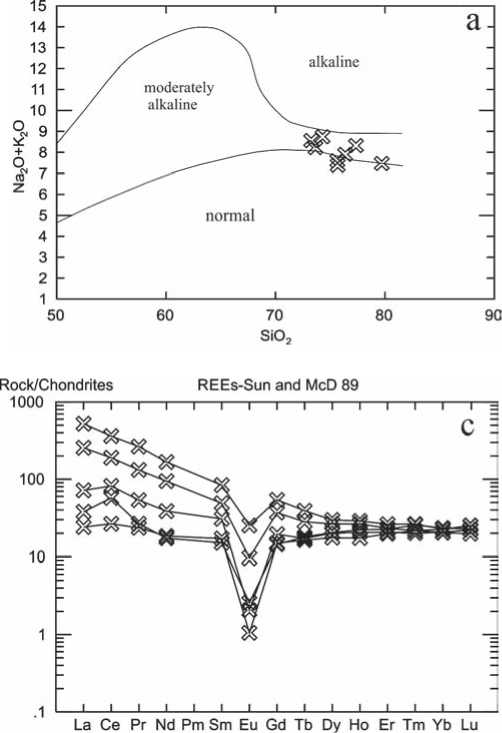
Fig. 3. Diagrams SiO2-Na2O+K2O (a), diagrams Ab-An-Or (b), spectra of rare earths (c) and diagram multi-elemental (d)
Ðèñ. 3. Äèàãðàììà SiO2-Na2O+K2O (a), äèàãðàììà Î`Êîííåðà Ab-An-Or (b), ñïåêòðû ðàñïðåäåëåíèÿ ÐÇÝ (c), ìóëüòèýëåìåí-òíàÿ äèàãðàììà (d)
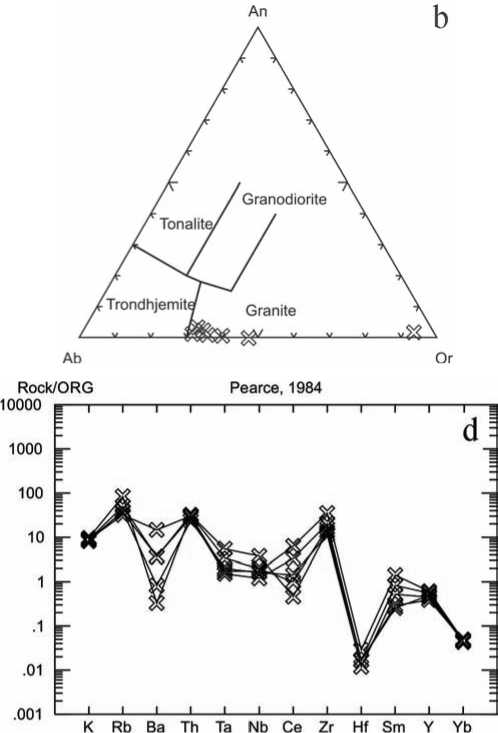
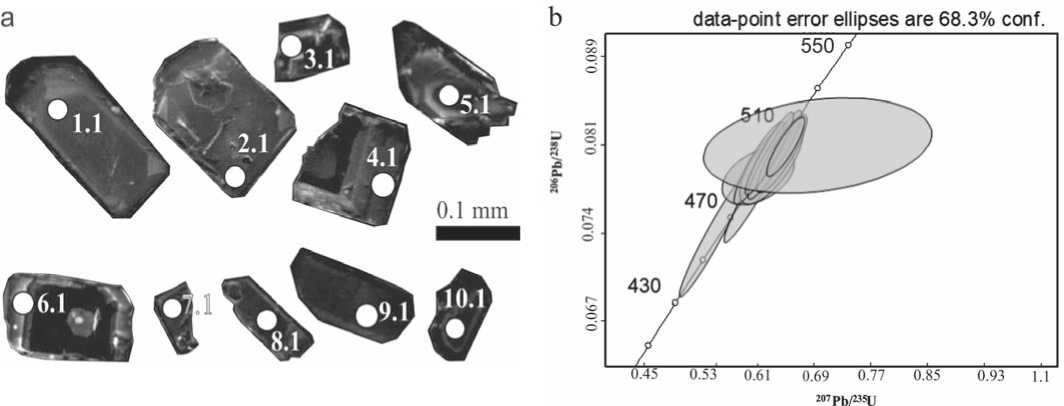
Fig. 4. Cathodoluminescence image of zircon from granites (A52-14) numbers dating grains and analysis of craters (a); Diagram for zircon A52-14 — (b). The coordinates of points — the center of the ellipse of error (2 σ ). Concordant age for coherent groups of 10 definitions — (496.2 ± 7.1) million years (2 σ , STD (standard deviation) = 0.85)
Ðèñ. 4. Êàòîäîëþìèíåñöåíòíûå èçîáðàæåíèÿ öèðêîíîâ èç ãðàíèòîâ (À52-14) ñ íîìåðàìè äàòèðîâàííûõ çåðåí è àíàëèòè-÷åñêèõ êðàòåðîâ (a); äèàãðàììà äëÿ öèðêîíîâ îáð. À52-14 – (b). Êîîðäèíàòû òî÷åê – öåíòðû ýëëèïñîâ ïîãðåøíîñòåé (2 σ ). Êîíêîðäàíòíûé âîçðàñò äëÿ êîãåðåíòíîé ãðóïïû èç 10 îïðåäåëåíèé — (496.2±7.1) ìëí ëåò (2 σ , ÑÊÂÎ=0.85)
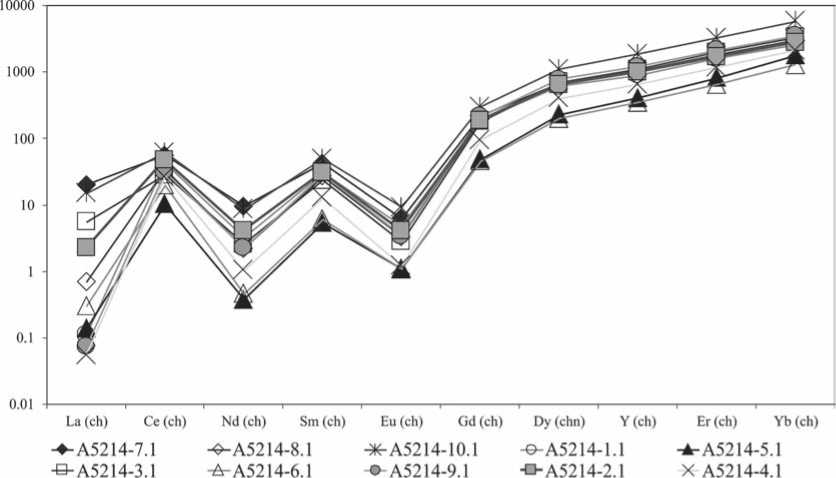
Fig. 5. Spectra of REE distribution in analyzed zircons from granitoids of the Gerdiz massif
Ðèñ. 5. Ñïåêòðû ðàñïðåäåëåíèÿ ÐÇÝ â öèðêîíàõ èç ãðàíèòîèäîâ Ãåðäèçñêîãî ìàññèâà
with inclusions and numerous cracks. Cathodoluminescent images of zircons show rough oscillatory zoning in the margins of zircons and wide homogeneous central zones (fig. 4a). The contents of U (ppm) are highly variable from 196 to 1091, but are generally at 300. The content of Th varies within a tighter range of 83–270.
The calculated 206Pb/238U zircon crystallization age was determined from 10 points on sample A52/14 (tab. 2). The results range in ages from 461.5±19.2 to 502.2±9.3 Ma (fig. 4b). The calculated weighted mean age of 10 zircon analyses was 494.9±7.9 Ma (2σ, MSWD = 0.53, probability — 0.85). This calculated concordia age for the coherent group from all 10 definitions is 496.2±7.1 Ma (2σ, MSWD = 0.85, the probability of concordance - 0.721) is within uncertainty of the weighted average (fig. 4b). The trace elements contents are similar, indicating that the analyzed zir- 28
cons are comagmatic (fig.5). Their formation temperature estimated by the Ti content in zircon [17] varies over a wide range from 645 to 728 °C (at a SiO = 1 and a TiO2 = 0.7).
The concordant age obtained corresponds to the Late Cambrian. The identified age of metagranitoids of the Ingilorskiy massif is similar and is 487.3 ± 7.4 [9]. A Paypudynsky rhyolite complex (λª3-O1 pp ) of the same age level is known in the Polar Urals, which is the felsic component of bimodal rift magmatism in the Polar Urals [2].
The Sm-Nd data of granite sample A52/14, (Sm (12.79 ppm), Nd (82.98 ppm), 147Sm/144Nd (0.0932), 143Nd/144Nd (0.512338), εNd(0) (–5.9), eNd(T) (+0.7), TDM (1029), TDM2 (1181)) [8] indicate that the source of these rocks was either mantle with a significant component of older crust as a contamination. The oxygen isotopic composition of zircons from granitoids (zircon from sam- ple A52/14) is characterized by low values of+6.9 %o [8] -has core values.
The isotopic data of Hf (tab.3), calculated on age sHf (T), is characterized by positive values from + 4.87 to +2.15, which indicate a crust-mantle source (which agrees well with eNd(t), on the data presented above) and young model age.
Isotope-geochemical (sNd(t), OZrn, sHf(t)Zrn) data allow us to characterize the source of the melts
Conclusions
Thus, according to new petrologic, geochemical, geochronologic and isotopic data, granitoids of the northern part of the Gerdizskiy massif have intraplate characteristics and document that they mark the process of rifting that existed in the late Cambrian along the margin of the East European continent.
Studies are conducted within the framework of the project 18-5-5-46
Список литературы Granites of the Gerdiz massif (Polar Urals): new data
- Государственная геологическая карта Российской Федерации масштаба 1:200000: Серия Полярно-Уральская. Лист Q-42-I, II (Лаборовая). Объяснительная записка / Ред. А. П. Казак. СПб.: Картографическая фабрика ВСЕГЕИ, 2009. 372 с.
- Зархидзе Д. В., Малых О. Н. и др. Государственная геологическая карта Российской Федерации. Масштаб 1: 200 000. Издание второе. Серия Полярно-Уральская. Листы R-41-XXXV, XXXVI (хр. Оченырд). Объяснительная записка. М.: Московский филиал ФГБУ «ВСЕГЕИ», 2017. 224 с. (Минприроды России, Роснедра, Комитет природных ресурсов по Республике Коми, ЗАО «МИРЕКО»).
- Махлаев Л. В. Гранитоиды севера Центрально-Уральского поднятия (Полярный и Приполярный Урал). Екатеринбург: УрО РАН, 1996. 148 с.
- Охотников В. Н. Гранитоиды и рудообразование (Полярный Урал). Л.: Наука, 1985. 184 с.
- Шишкин М. А., Криночкин В. Г. Легенда для геологической карты донеогеновых образований Полярно-Уральской серии листов Госгеолкарты-200. Санкт-Петербург, 1999. 198 с.

